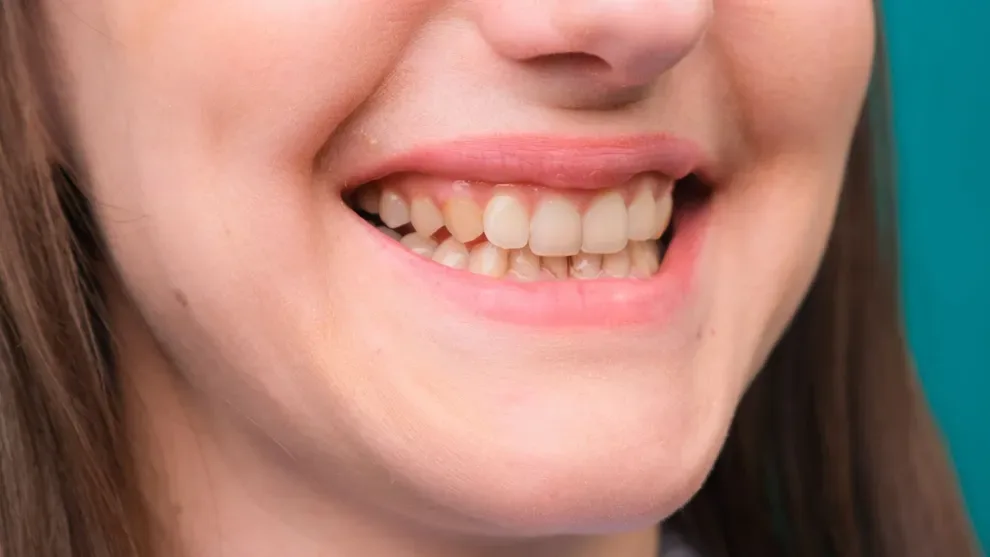Dental Fluorosis: Causes, Symptoms & Best Treatments

Table of Contents
- What Is Dental Fluorosis
- Can Dental Fluorosis Cause Harm
- Are There Treatments for Fluorosis
- References
Dental fluorosis is caused by too much exposure to fluoride as adult teeth form in children’s mouths. Mild cases are common, which might appear as white spots or streaks, or an appearance of off-white teeth with white bottom edges.
Moderate or severe cases can cause thin and pitted enamel, which can lead to other oral health problems.
What Is Dental Fluorosis?
Grand Rapids, Michigan, became the first city in the United States to fluoridate its water as a way to reduce cavities and tooth decay in the general population. Since then, over 70 percent of the American population has access to water that has been supplemented by fluoride. This has ensured that many people have healthier teeth and gums than they might without this supplement.
However, some places are removing fluoride from the water. Many people are beginning to drink bottled, non-fluoridated water, as there are concerns about the effect of too much fluoride, including as a potential cause of cancer.
One of the possible health issues associated with too much fluoride is dental fluorosis, a condition that looks like changes to the tooth enamel but can cause more serious dental problems. Most instances of dental fluorosis are mild and can cause a very white, pearly appearance to the teeth, especially the front teeth. Worn enamel from more moderate or severe instances of dental fluorosis can increase your risk of poor dental health.
Dental fluorosis affects almost one in four Americans between the ages of 6 to 49 years of age and is most common in those 12 to 15 years of age.
Can Dental Fluorosis Cause Harm?
Although there are many cases of dental fluorosis in the US, most of these are very mild or mild. This means that the teeth may have a slightly unusual appearance. They can be very white, pearlescent with a thinner appearance (especially the front teeth), or they can develop white spots or streaks on the surface.
This is caused by hyper-mineralization of the surface of the teeth. It typically begins in the lower incisors, which finish forming around 2 to 3 years old. Worsened fluorosis can lead to a permanently stained appearance of the teeth, as the enamel is very thin, so the teeth will appear off-white, yellow, or even brown.
It is unlikely for someone living in the US, either a child or an adult, to develop more severe forms of dental fluorosis. Most municipal water supplies maintain a fluoride level of about 1 milligram per liter, and moderate to severe fluorosis develops with fluoride levels of 2 milligrams per liter of water. Children who are exposed to too much fluoride as they grow up can develop this condition.
Dental fluorosis is caused by too much fluoride over a long period of time as permanent teeth develop. Children 8 years old and younger are at most risk of developing this condition because their baby teeth are not yet gone, and their adult teeth are mostly still forming or just starting to come in.
Fluoride toothpaste, water with high levels of fluoride, dietary supplements or prescription medications, or even consuming fluoride by accident are all associated with the development of dental fluorosis. Severe dental fluorosis is not common. The World Health Organization (WHO) notes that fluorosis is most likely to occur because of an accident or natural disaster that causes too much fluoride exposure or seeps fluoride into the drinking water.
Dental fluorosis might look like:
Scattered white flecks that appear to be just under the surface of the enamel.
Occasional white spots.
Frosty lines along the bottom of the teeth.
Lacy or chalk-like lines along the teeth.
Larger white flecks, white and off-white striations on the teeth, or off-white teeth with bright white edges (with moderate forms of dental fluorosis).
Enamel fluorosis, or mild fluorosis, is fairly common. Dentin fluorosis, which is deeper in the teeth, can create instabilities in your child’s dental health, which can cause problems with cavities throughout life, shifting teeth, thinner enamel leading to cracks or chips, and other problems.
Are There Treatments for Fluorosis?
Although dental fluorosis can be severe and this can impact oral health over a lifetime, it is not a disease. Once dental fluorosis begins to affect tooth development, it can be mitigated by reducing fluoride consumption, but there is no way to treat it or stop it in adult teeth.
If you are an adult and you suspect you have dental fluorosis that impacts your dental health, ask your dentist for a diagnosis. They may tell you that you have serious dental fluorosis, which is leading to problems with tooth chipping, cracks, or cavities.
If you have young children and are concerned about them developing dental fluorosis, you can check your water supply’s fluoride content online. You can also call your water company and ask about their fluoride content. If there is fluoride in the municipal water supply, you can stop using fluoride toothpaste to support your child’s dental health, or talk to your pediatric dentist about other options to reduce the amount of fluoride your child consumes if they take medications that might contain this chemical.
On the other hand, if your local water supply does not have fluoride or enough fluoride, you’ll want to use a fluoridated toothpaste to support their dental health as they grow.
